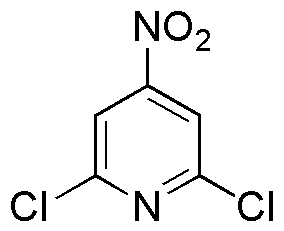2,6-Dichloro-4-nitropyridine is widely utilized in research focused on:
- Pesticide Development: This compound is often used in the synthesis of agrochemicals, particularly in the formulation of pesticides that target specific pests while minimizing harm to beneficial organisms.
- Pharmaceuticals: It serves as an intermediate in the production of various pharmaceutical agents, contributing to the development of medications that treat a range of conditions.
- Material Science: The chemical is employed in the creation of specialized materials, including polymers and coatings, which enhance durability and resistance to environmental factors.
- Analytical Chemistry: It is used as a reagent in analytical methods, aiding researchers in the detection and quantification of other chemical substances in complex mixtures.
- Research Applications: This compound is valuable in academic and industrial research settings for studying reaction mechanisms and developing new synthetic pathways.
General Information
Properties
Safety and Regulations
Applications
2,6-Dichloro-4-nitropyridine is widely utilized in research focused on:
- Pesticide Development: This compound is often used in the synthesis of agrochemicals, particularly in the formulation of pesticides that target specific pests while minimizing harm to beneficial organisms.
- Pharmaceuticals: It serves as an intermediate in the production of various pharmaceutical agents, contributing to the development of medications that treat a range of conditions.
- Material Science: The chemical is employed in the creation of specialized materials, including polymers and coatings, which enhance durability and resistance to environmental factors.
- Analytical Chemistry: It is used as a reagent in analytical methods, aiding researchers in the detection and quantification of other chemical substances in complex mixtures.
- Research Applications: This compound is valuable in academic and industrial research settings for studying reaction mechanisms and developing new synthetic pathways.
Documents
Safety Data Sheets (SDS)
The SDS provides comprehensive safety information on handling, storage, and disposal of the product.
Product Specification (PS)
The PS provides a comprehensive breakdown of the product’s properties, including chemical composition, physical state, purity, and storage requirements. It also details acceptable quality ranges and the product's intended applications.
Certificates of Analysis (COA)
Search for Certificates of Analysis (COA) by entering the products Lot Number. Lot and Batch Numbers can be found on a product’s label following the words ‘Lot’ or ‘Batch’.
*Catalog Number
*Lot Number
Certificates Of Origin (COO)
This COO confirms the country where the product was manufactured, and also details the materials and components used in it and whether it is derived from natural, synthetic, or other specific sources. This certificate may be required for customs, trade, and regulatory compliance.
*Catalog Number
*Lot Number
Safety Data Sheets (SDS)
The SDS provides comprehensive safety information on handling, storage, and disposal of the product.
DownloadProduct Specification (PS)
The PS provides a comprehensive breakdown of the product’s properties, including chemical composition, physical state, purity, and storage requirements. It also details acceptable quality ranges and the product's intended applications.
DownloadCertificates of Analysis (COA)
Search for Certificates of Analysis (COA) by entering the products Lot Number. Lot and Batch Numbers can be found on a product’s label following the words ‘Lot’ or ‘Batch’.
*Catalog Number
*Lot Number
Certificates Of Origin (COO)
This COO confirms the country where the product was manufactured, and also details the materials and components used in it and whether it is derived from natural, synthetic, or other specific sources. This certificate may be required for customs, trade, and regulatory compliance.


